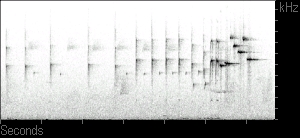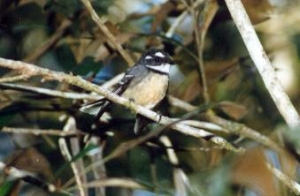 Grey Fantail
Grey Fantail Rhipidura fuliginosa
 Figure 1. Spectrogram of the
Grey Fantail song.
Figure 1. Spectrogram of the
Grey Fantail song. (The first song from the sound file is depicted.)

Image from David & Diane Armbrust's Australian Natural History Safari.
Grey Fantail - Rhipidura fuliginosa
Grey fantails are probably less widely known than their close relatives, willie wagtails, Rhipidura lecophrys, who live in parks and suburbs throughout Australia. Like willie wagtails, grey fantails keep their tails in constant motion, bobbing and pivoting their tails in wide arcs. Grey fantails routinely open and flash their fanned tail as they sally and dive trough the air to catch insects. By flashing their tails, fantails and wagtails may accomplish a similar goal to painted redstarts, who use seemingly erratic tail movements to frighten insects and steer their flight path to make them easier to catch.
Grey fantails also perform impressive acrobatics with their voices. Grey fantial songs consist of a quiet introductory phase and a loud terminal phase. The introductory phase consists of a series of repeated syllables that slowly accelerate and gently increase in volume. The most prominent introductory syllable may be repeated as many as 20 times and may last for up to 10 seconds. At very close range I have heard grey fantails preceed these repeated syllables with an extended bout of very quiet warbling song. The terminal phase of grey fantail song continues to grow in volume as the birds give seven to nine terminal syllables. The entire song is very high-pitched, falling between 4.5 and 8.5 kHz. Recording birds in New South Wales, the illustrious Allen Keast found that grey fantails sing shorter songs with fewer terminal syllables in the southeastern part of their range.
Habitat.
Grey fantails are habitat generalists, and are found in a wide variety of forested habitats from thickets to rainforest.
Range.
Altogether, five subspecies of grey fantail inhabit almost all of Australia. The subspecies recorded here is R. f. keasti, which is found east of the great dividing range in northeastern Australia.
Further Reading.
P. F. Jablonski. 2001. Sensory exploitation of prey: manipulation of the initial direction of prey escapes by a conspicuous ‘rare enemy’. Proceedings of the Royal Society of London B. 268:1017-1022.
A. Keast. 1993. Song structures
and characteristics:
Members of a eucalypt forest bird community compared. Emu. 93:259-268.
No recordings, photographs, or other information may be used without written permission (email me at dmennill AT uwindsor DOT ca).